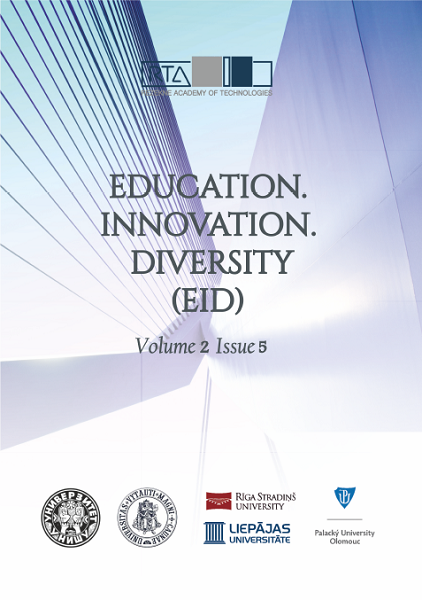EU YOUTH BELIEFS IN GENDER BASED DISCRIMINATION, SEXUAL HARASSMENT AND SEXUAL ASSAULT
DOI:
https://doi.org/10.17770/eid2022.2.6963Keywords:
beliefs, gender based discrimination, sexual harassment, sexual assault, valuesAbstract
Gender based discrimination, sexual harassment and sexual assault are the factors that impact youth engagement in the labour market and society. Monitoring of gender based discrimination, sexual harassment and sexual assault among young people in the European countries remains under-developed. The research aim is to analyse beliefs of young people in the European Union in gender based discrimination, sexual harassment and sexual assault. The research is built on the basis of both theoretical and empirical methods. The theoretical analysis shaped the conceptual framework of the research. The empirical study was based on the survey implementation. Data were collected in five European Union countries in March-April 2022. The data were analysed via the mean calculation as well as ranking. Data interpretation was applied in order to summarise the study findings. The theoretical analysis allows for the establishment of the inter-connections between beliefs and values. The data analysis reveals that young people believe in gender based discrimination, sexual harassment and sexual assault. The results show that physical appearance and people race are the Top 2 beliefs that coincide in all the three phenomena, namely gender based discrimination, sexual harassment and sexual assault. Research limitations are outlined. Future work is proposed.
References
Ahrens, A. & Zascerinska, J. (2020). Comparison of Teacher’s and Students’ Ranking of English for Academic Purposes Sub-Topics. Education. Innovation. Diversity, 1(1), 16-25. DOI: http://dx.doi.org/10.17770/eid2020.1.5328
Coe, R. (2010). Analysing ranking and rating data from participatory on-farm trials. African Statistics Journal, 10, 14- 53. Retrieve from http://apps.worldagroforestry.org/downloads/Publications/PDFS/JA10133.pdf
Elbow, Peter, (1994). Ranking, Evaluating, Liking: Sorting Out Three Forms of Judgment. College English. 12. Retrieved from https://scholarworks.umass.edu/eng_faculty_pubs/12
European Commission (EC). (2018). EU Youth Strategy. Retrieved from https://europa.eu/youth/strategy_en.
European Institute for Gender Equality (EIGE) (2015). Unwanted Sexual Attention Among Working Population. Retrieved from: https://eige.europa.eu/gender-statistics/dgs/indicator/genvio_sex_assa_sur__ewcs_unwantedsexatten.
European Parliament. (2012). Gender inequalities in the European Union. Report. Flash Eurobarometer 341 - TNS Political & Social. Retrieved from https://www.europarl.europa.eu/at-your-service/files/be-heard/eurobarometer/2012/the-gender-inequalities-in-the-european-union/aggregate-report/en-aggregate-report-the-gender-inequalities-in-the-european-union-201203.pdf
Forman-Rabinovici, Aliza , Udi Sommer. (2018). An impediment to gender Equality?: Religion’s influence on development and reproductive policy. World Development, Volume 105, 2018, 48-58. DOI: https://doi.org/10.1016/j.worlddev.2017.12.024.
Lee, H., Son, I., Yoon, J., Kim, S-S. (2017). Lookism hurts: appearance discrimination and self-rated health in South Korea. Int J Equity Health 16, 204(2017). DOI: https://doi.org/10.1186/s12939-017-0678-8.
Marginson, S., & van der Wende, M. (2007). To Rank or To Be Ranked: The Impact of Global Rankings in Higher Education. Journal of Studies in International Education, Vol. 11, 3/4, 306-329. DOI:10.1177/1028315307303544.
Österholm, Magnus. (2009). Beliefs: A Theoretically Unnecessary Construct? Proceedings of CERME 6, January 28th-February 1st 2009, Lyon France © INRP 2010. Retrieved from www.inrp.fr/editions/cerme6 .
Perry, BL, Harp, KL, & Oser, CB. (2013). Racial and Gender Discrimination in the Stress Process: Implications for African American Women's Health and Well-Being. Sociol Perspect, 56(1), 25-48. Retrieved from https://www.ncbi.nlm.nih.gov/pmc/articles/PMC3783344/
Xiao, Y., Zong, L., Geng, J., Deng, Z., & Zhu, S. (2020). Analysis of demographic profile, sexual offenses and defense ability among intellectually disabled females. Forensic Science International: Reports, Volume 2, 100121. DOI: https://doi.org/10.1016/j.fsir.2020.100121
Zaščerinska, J. (2011). Language Acquisition and Language Learning: Developing the System of External and Internal Perspectives. In: Zuģicka I., sast. Proceedings of the 52nd International Scientific Conference of Daugavpils University (pp. 412-417). Daugavpils: Daugavpils Universitātes Akadēmiskais apgāds „Saule”, 2011, Latvia.






